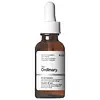What's inside
What's inside
 Key Ingredients
Key Ingredients

 Benefits
Benefits

 Concerns
Concerns

No concerns
 Ingredients Side-by-side
Ingredients Side-by-side

Water
Skin ConditioningGlycerin
HumectantCaprylic/Capric Triglyceride
MaskingC12-16 Alcohols
EmollientCyclopentasiloxane
EmollientPEG-8
HumectantPolyacrylate-13
Hydrogenated Lecithin
EmulsifyingPalmitic Acid
EmollientPrunus Domestica Seed Oil
Skin ConditioningPolyisobutene
Cyclohexasiloxane
EmollientSucrose Palmitate
EmollientParfum
MaskingDimethicone Crosspolymer
Emulsion StabilisingSteareth-20
CleansingCaprylyl Glycol
EmollientChlorphenesin
AntimicrobialHesperidin Methyl Chalcone
AntioxidantTetrasodium EDTA
Glyceryl Linoleate
EmollientPolysorbate 20
EmulsifyingTromethamine
BufferingPrunus Amygdalus Dulcis Oil
Skin ConditioningSodium Chloride
MaskingSodium Polyacrylate
AbsorbentChlorhexidine Digluconate
AntimicrobialGlucose
HumectantPhenoxyethanol
PreservativeSodium Hyaluronate
HumectantPotassium Sorbate
PreservativeCitric Acid
BufferingN-Hydroxysuccinimide
Skin ConditioningPotassium Chloride
Dipeptide-2
Skin ConditioningCalcium Chloride
AstringentMagnesium Sulfate
Glutamine
Skin ConditioningSodium Phosphate
BufferingPalmitoyl Tetrapeptide-7
Skin ConditioningAscorbic Acid
AntioxidantSodium Acetate
BufferingTocopherol
AntioxidantLysine Hcl
Skin ConditioningArginine
MaskingAlanine
MaskingHistidine
HumectantValine
MaskingChrysin
Skin ConditioningPalmitoyl Oligopeptide
CleansingLeucine
Skin ConditioningThreonine
Isoleucine
Skin ConditioningTryptophan
MaskingPhenylalanine
MaskingTyrosine
MaskingGlycine
BufferingPolysorbate 80
EmulsifyingSerine
Masking2'-Deoxyadenosine
Cystine
MaskingCyanocobalamin
Skin ConditioningDeoxycytidine
Deoxyguanosine
Thymidine
Skin ConditioningGlutathione
Asparagine
MaskingAspartic Acid
MaskingOrnithine
Skin ConditioningGlutamic Acid
HumectantNicotinamide Adenine Dinucleotide
Skin ConditioningProline
Skin ConditioningAminobutyric Acid
Methionine
Skin ConditioningTaurine
BufferingHydroxyproline
Skin ConditioningGlucosamine
Coenzyme A
Skin ConditioningGlucuronolactone
Skin ConditioningSodium Glucuronate
HumectantThiamine Diphosphate
Skin ConditioningDisodium Flavine Adenine Dinucleotide
Sodium Trimetaphosphate
BufferingRetinyl Acetate
Skin ConditioningInositol
HumectantNiacin
SmoothingNiacinamide
SmoothingPyridoxal 5-Phosphate
Skin ConditioningPyridoxine
Skin ConditioningBiotin
AntiseborrhoeicCalcium Pantothenate
Folic Acid
Skin ConditioningRiboflavin
Cosmetic ColorantTocopheryl Phosphate
CleansingWater, Glycerin, Caprylic/Capric Triglyceride, C12-16 Alcohols, Cyclopentasiloxane, PEG-8, Polyacrylate-13, Hydrogenated Lecithin, Palmitic Acid, Prunus Domestica Seed Oil, Polyisobutene, Cyclohexasiloxane, Sucrose Palmitate, Parfum, Dimethicone Crosspolymer, Steareth-20, Caprylyl Glycol, Chlorphenesin, Hesperidin Methyl Chalcone, Tetrasodium EDTA, Glyceryl Linoleate, Polysorbate 20, Tromethamine, Prunus Amygdalus Dulcis Oil, Sodium Chloride, Sodium Polyacrylate, Chlorhexidine Digluconate, Glucose, Phenoxyethanol, Sodium Hyaluronate, Potassium Sorbate, Citric Acid, N-Hydroxysuccinimide, Potassium Chloride, Dipeptide-2, Calcium Chloride, Magnesium Sulfate, Glutamine, Sodium Phosphate, Palmitoyl Tetrapeptide-7, Ascorbic Acid, Sodium Acetate, Tocopherol, Lysine Hcl, Arginine, Alanine, Histidine, Valine, Chrysin, Palmitoyl Oligopeptide, Leucine, Threonine, Isoleucine, Tryptophan, Phenylalanine, Tyrosine, Glycine, Polysorbate 80, Serine, 2'-Deoxyadenosine, Cystine, Cyanocobalamin, Deoxycytidine, Deoxyguanosine, Thymidine, Glutathione, Asparagine, Aspartic Acid, Ornithine, Glutamic Acid, Nicotinamide Adenine Dinucleotide, Proline, Aminobutyric Acid, Methionine, Taurine, Hydroxyproline, Glucosamine, Coenzyme A, Glucuronolactone, Sodium Glucuronate, Thiamine Diphosphate, Disodium Flavine Adenine Dinucleotide, Sodium Trimetaphosphate, Retinyl Acetate, Inositol, Niacin, Niacinamide, Pyridoxal 5-Phosphate, Pyridoxine, Biotin, Calcium Pantothenate, Folic Acid, Riboflavin, Tocopheryl Phosphate
Water
Skin ConditioningButylene Glycol
HumectantNicotiana Benthamiana Hexapeptide-40 Sh-Oligopeptide-1
Skin ConditioningNicotiana Benthamiana Hexapeptide-40 Sh-Polypeptide-76
Skin ConditioningNicotiana Benthamiana Octapeptide-30 Sh-Oligopeptide-2
Skin ConditioningWater, Butylene Glycol, Nicotiana Benthamiana Hexapeptide-40 Sh-Oligopeptide-1, Nicotiana Benthamiana Hexapeptide-40 Sh-Polypeptide-76, Nicotiana Benthamiana Octapeptide-30 Sh-Oligopeptide-2, Sclerotium Gum, Glycerin, Trisodium Ethylenediamine Disuccinate, Citric Acid, Sodium Citrate, Phenoxyethanol, Chlorphenesin
 Reviews
Reviews

Ingredients Explained
These ingredients are found in both products.
Ingredients higher up in an ingredient list are typically present in a larger amount.
Chlorphenesin is a synthetic preservative. It helps protect a product against bacteria in order to extend shelf life. In most cases, Chlorphenesin is paired with other preservatives such as phenoxyethanol and caprylyl glycol.
Chlorphenesin is a biocide. This means it is able to help fight the microorganisms on our skin. It is also able to fight odor-releasing bacteria.
Chlorphenesin is soluble in both water and glycerin.
Studies show Chlorphenesin is easily absorbed by our skin. You should speak with a skincare professional if you have concerns about using Chlorphenesin.
Learn more about ChlorphenesinCitric Acid is an alpha hydroxy acid (AHA) naturally found in citrus fruits like oranges, lemons, and limes.
Like other AHAs, citric acid can exfoliate skin by breaking down the bonds that hold dead skin cells together. This helps reveal smoother and brighter skin underneath.
However, this exfoliating effect only happens at high concentrations (20%) which can be hard to find in cosmetic products.
Due to this, citric acid is usually included in small amounts as a pH adjuster. This helps keep products slightly more acidic and compatible with skin's natural pH.
In skincare formulas, citric acid can:
While it can provide some skin benefits, research shows lactic acid and glycolic acid are generally more effective and less irritating exfoliants.
Most citric acid used in skincare today is made by fermenting sugars (usually from molasses). This synthetic version is identical to the natural citrus form but easier to stabilize and use in formulations.
Read more about some other popular AHA's here:
Learn more about Citric AcidGlycerin is already naturally found in your skin. It helps moisturize and protect your skin.
A study from 2016 found glycerin to be more effective as a humectant than AHAs and hyaluronic acid.
As a humectant, it helps the skin stay hydrated by pulling moisture to your skin. The low molecular weight of glycerin allows it to pull moisture into the deeper layers of your skin.
Hydrated skin improves your skin barrier; Your skin barrier helps protect against irritants and bacteria.
Glycerin has also been found to have antimicrobial and antiviral properties. Due to these properties, glycerin is often used in wound and burn treatments.
In cosmetics, glycerin is usually derived from plants such as soybean or palm. However, it can also be sourced from animals, such as tallow or animal fat.
This ingredient is organic, colorless, odorless, and non-toxic.
Glycerin is the name for this ingredient in American English. British English uses Glycerol/Glycerine.
Learn more about GlycerinPhenoxyethanol is a preservative that has germicide, antimicrobial, and aromatic properties. Studies show that phenoxyethanol can prevent microbial growth. By itself, it has a scent that is similar to that of a rose.
It's often used in formulations along with Caprylyl Glycol to preserve the shelf life of products.
Water. It's the most common cosmetic ingredient of all. You'll usually see it at the top of ingredient lists, meaning that it makes up the largest part of the product.
So why is it so popular? Water most often acts as a solvent - this means that it helps dissolve other ingredients into the formulation.
You'll also recognize water as that liquid we all need to stay alive. If you see this, drink a glass of water. Stay hydrated!
Learn more about Water